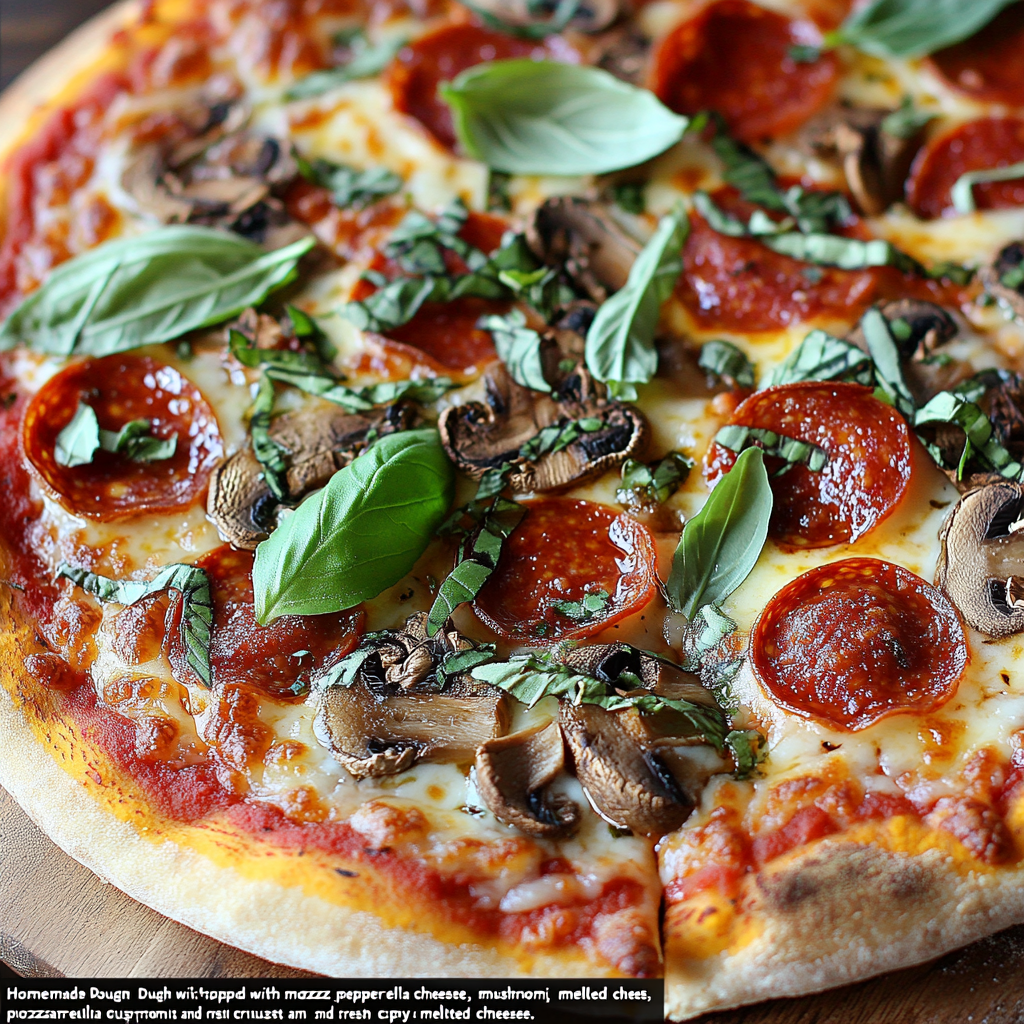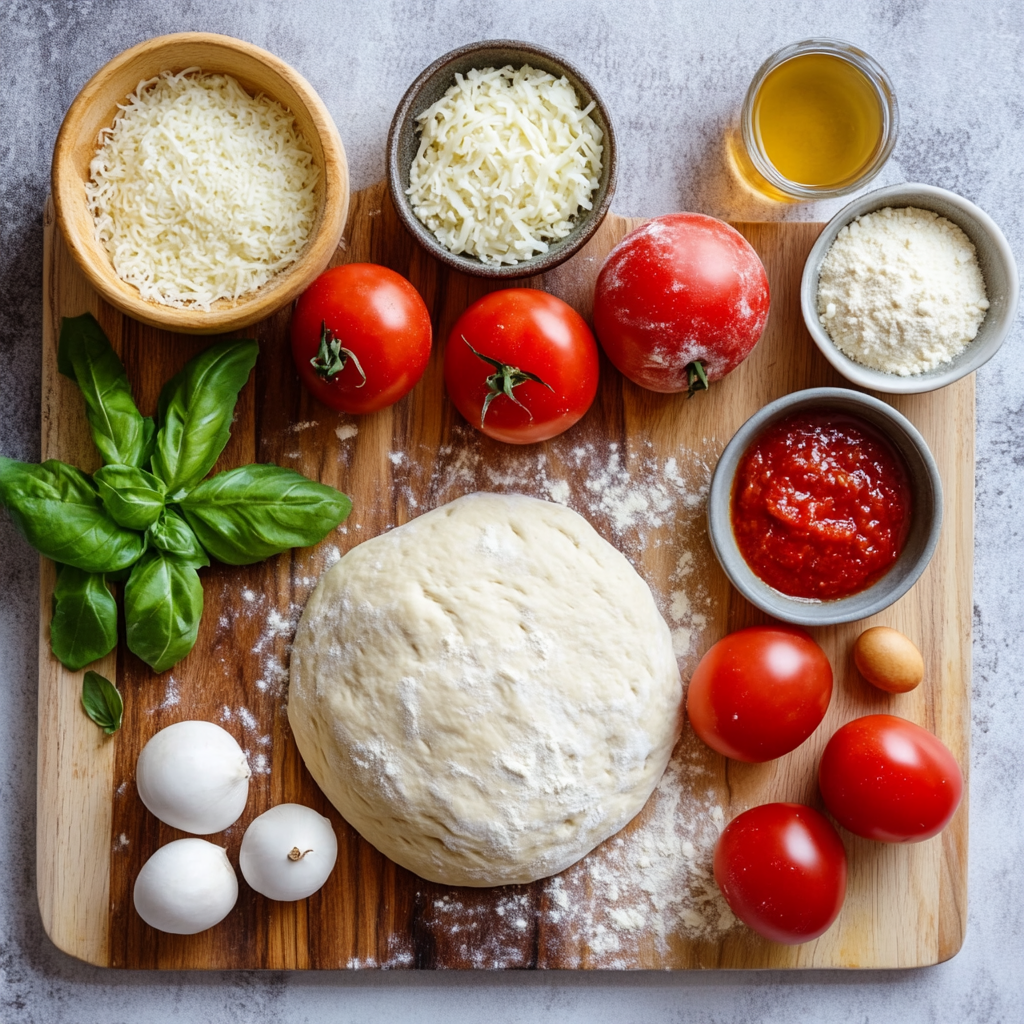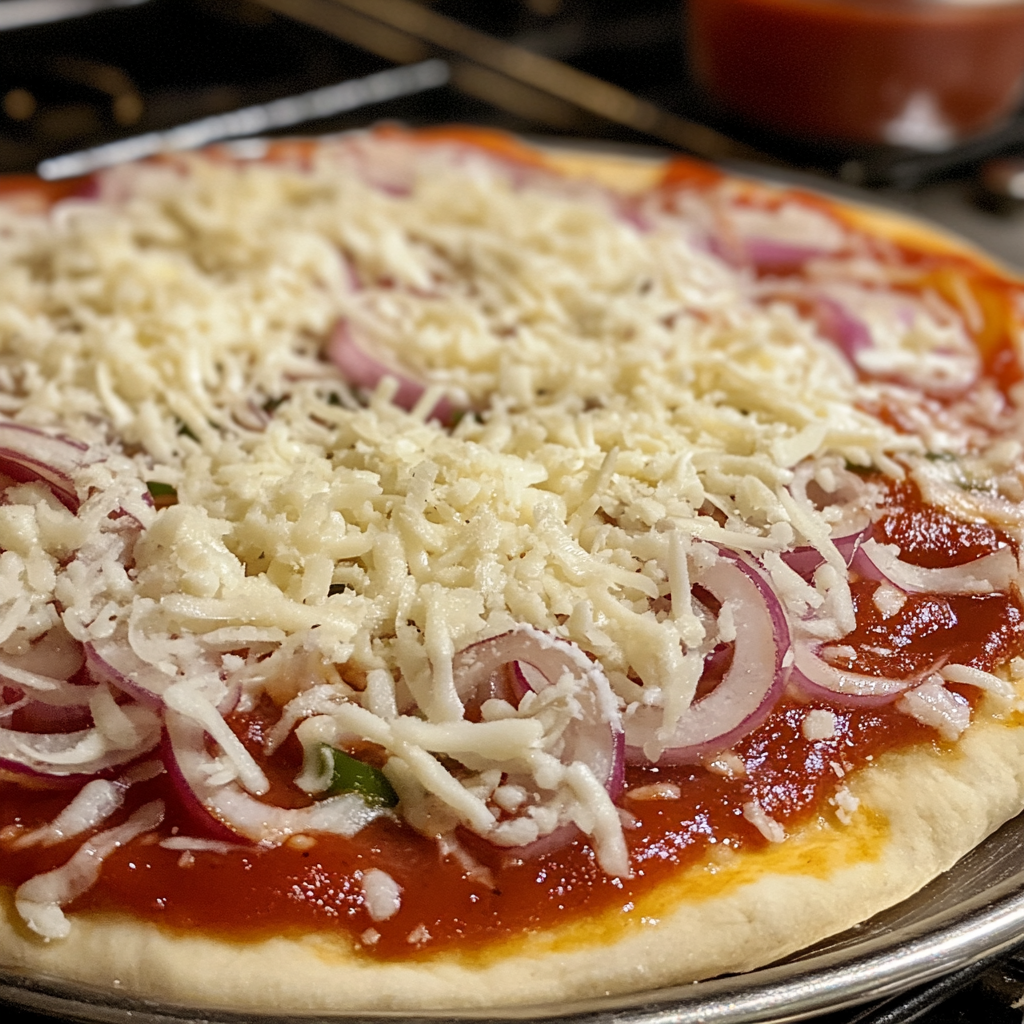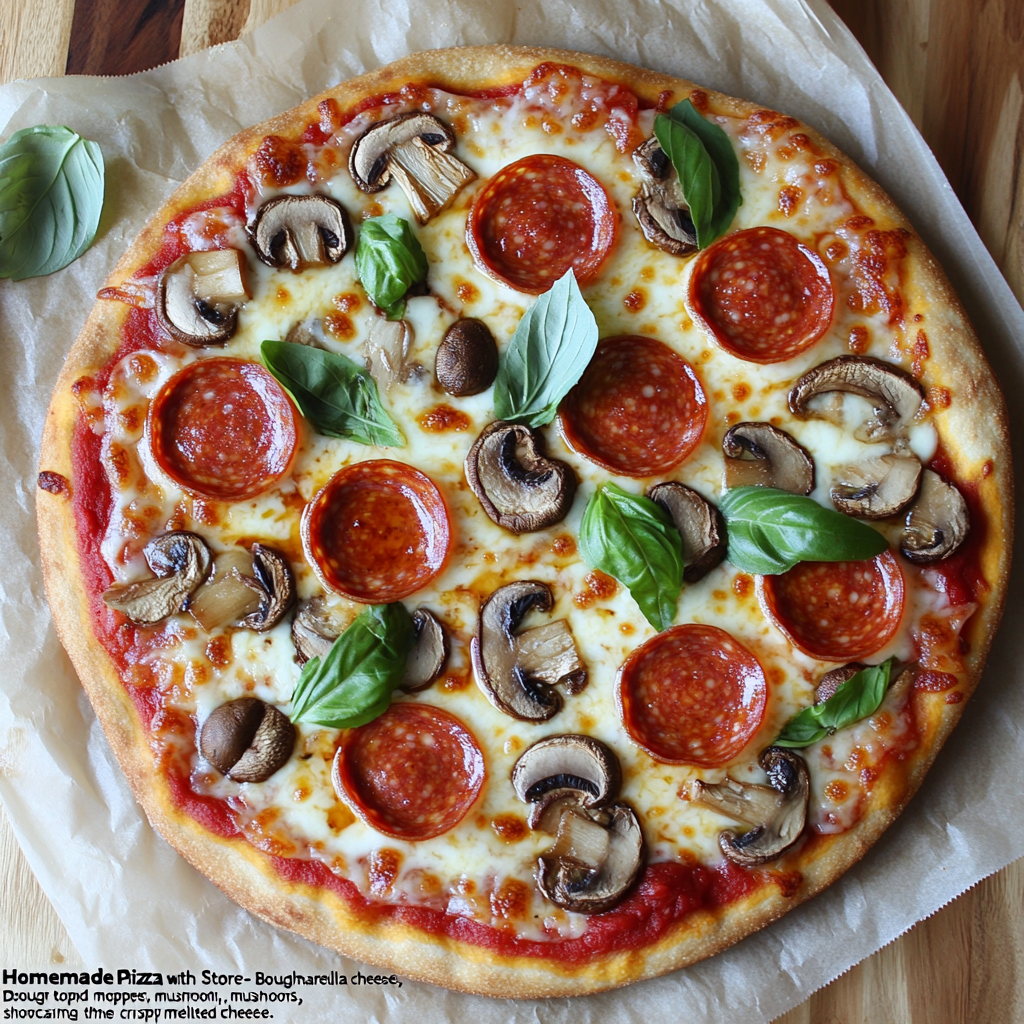Making homemade pizza doesn’t have to be a complicated or time-consuming process. With store-bought dough, you can easily whip up a delicious pizza right in your own kitchen without needing special skills or a lot of ingredients. This simple recipe will guide you through the steps, from preparing the dough to adding your favorite toppings, ensuring you have a tasty pizza in no time.

PART 1: Why Use Store-Bought Dough for Homemade Pizza?
- The Convenience of Store-Bought Pizza Dough
- Save Time and Effort While Still Enjoying a Fresh Pizza
Store-bought dough is a great shortcut when you’re craving homemade pizza but don’t have the time or energy to make dough from scratch. It cuts down on prep time significantly while still giving you the flexibility to personalize your pizza with whatever toppings you love.
The Convenience of Store-Bought Pizza Dough
Store-bought pizza dough is a perfect option for busy weeknights or casual gatherings. Most grocery stores offer pre-made dough in the refrigerated or frozen section, which is ready to roll out and use. All you need to do is defrost it if it’s frozen and let it come to room temperature before stretching it into shape. This saves you time, so you can focus on creating a perfect pizza topping instead of spending hours kneading and waiting for dough to rise.
Save Time and Effort While Still Enjoying a Fresh Pizza
By using store-bought dough, you still get to enjoy the freshness of homemade pizza, with minimal effort. Whether you’re making a traditional margherita pizza or experimenting with gourmet toppings, the dough does most of the work for you, so you can be enjoying your pizza in less than 30 minutes.

PART 2: Ingredients You’ll Need to Make Homemade Pizza with Store-Bought Dough
- Store-Bought Pizza Dough
- Toppings and Sauces
The beauty of homemade pizza is the ability to customize it according to your tastes. You can use store-bought dough as the base and load it with your favorite toppings.
Store-Bought Pizza Dough
You can find a variety of pizza dough options in most grocery stores, ranging from classic white to whole wheat or gluten-free varieties. Pick whichever you prefer, but be sure to check whether it’s frozen or fresh, as frozen dough will need time to thaw.
Toppings and Sauces
The fun part of making pizza is choosing your toppings. Traditional options include mozzarella cheese, tomato sauce, pepperoni, mushrooms, and bell peppers. You can also get creative with gourmet ingredients like arugula, goat cheese, or sun-dried tomatoes. For the sauce, you can use store-bought pizza sauce, marinara, or even pesto if you’re feeling adventurous. Here’s a quick rundown of popular pizza toppings:
- Cheeses: Mozzarella, parmesan, cheddar, ricotta
- Proteins: Pepperoni, sausage, bacon, chicken, ham
- Vegetables: Bell peppers, onions, mushrooms, olives, spinach
- Garnishes: Fresh basil, arugula, chili flakes, balsamic glaze
PART 3: Preparing the Dough
- Defrosting Frozen Dough
- Stretching the Dough into Shape
Even though store-bought dough is convenient, handling it properly is key to ensuring a perfect pizza crust.
Defrosting Frozen Dough
If you’re using frozen dough, take it out of the freezer at least 2-3 hours before you want to make the pizza. This allows the dough to thaw and become soft and pliable. If you’re in a rush, you can microwave the dough for 15-second intervals, but this can sometimes affect its texture.
Stretching the Dough into Shape
Once the dough has thawed, flour your countertop or a large surface area, and gently roll or stretch the dough into a round shape. Be careful not to overwork it, or it might become tough. Use your hands to stretch it gently into your desired size and thickness, depending on whether you prefer a thin or thicker crust.

PART 4: Adding Sauce and Toppings
- Spread Your Sauce Evenly
- Layer Your Toppings Generously
Now comes the fun part—layering your pizza with the sauce, cheese, and toppings.
Spread Your Sauce Evenly
Use a spoon or a ladle to spread your sauce over the dough, leaving a small border around the edges for the crust. Don’t overload the pizza with sauce, or it might become soggy. A thin, even layer works best.
Layer Your Toppings Generously
Start with cheese as the base, followed by your choice of toppings. Make sure to spread the toppings evenly so every bite has a little bit of everything.
PART 5: Baking Your Pizza
- Preheat Your Oven
- Baking Times for Different Crust Thicknesses
Properly baking your pizza is crucial to achieving the perfect crispiness and meltiness.
Preheat Your Oven
Set your oven to 475°F (245°C) to ensure it is hot enough to bake the pizza evenly and quickly. Preheating the oven also ensures that the crust gets that desired crispy edge.
Baking Times for Different Crust Thicknesses
For a thin crust pizza, bake for about 10-12 minutes. For a thicker crust, you may need to bake it for around 15-18 minutes. Keep an eye on the pizza and check for a golden-brown crust and bubbling cheese.
PART 6: How to Know When Your Pizza is Done
- Check the Crust
- Look for Golden Cheese
The best way to check if your pizza is ready is by looking at the crust and cheese.
Check the Crust
Lift the pizza with a spatula to check underneath the crust. It should be golden brown and slightly crisp. If the crust is too pale, continue baking for a few more minutes.
Look for Golden Cheese
The cheese should be fully melted and slightly browned on top. If the cheese isn’t bubbling, give it a few extra minutes in the oven.
PART 7: Tips for Making the Best Homemade Pizza
- Use High-Quality Ingredients
- Experiment with New Toppings
Great pizza starts with great ingredients, so don’t be afraid to splurge on fresh, high-quality items.
Use High-Quality Ingredients
Invest in good mozzarella cheese, fresh herbs, and quality meats. The better the ingredients, the better the pizza will taste.
Experiment with New Toppings
Try different combinations of ingredients that you wouldn’t normally use. For instance, add fresh basil after baking, drizzle with a little honey, or top with roasted vegetables for a healthy twist.
PART 8: Common Mistakes to Avoid When Making Homemade Pizza
- Using Too Much Sauce
- Overloading the Toppings
Making pizza is a fun and creative process, but there are some common mistakes to avoid.
Using Too Much Sauce
A common mistake is applying too much sauce, which can result in a soggy pizza. Stick to a thin layer for the best results.
Overloading the Toppings
It’s tempting to load your pizza up with tons of toppings, but too many can weigh down the crust and make the pizza soggy. Keep the layers light for the perfect balance.
PART 9: Serving and Enjoying Your Homemade Pizza
- Let the Pizza Cool Before Slicing
- Pairing Your Pizza with Drinks
Once your pizza is ready, serve it up hot and fresh.
Let the Pizza Cool Before Slicing
Allow the pizza to cool for a couple of minutes before slicing. This lets the cheese set and makes cutting the pizza easier.
Pairing Your Pizza with Drinks
Pair your pizza with your favorite drinks. A nice chilled soda, iced tea, or even a glass of wine complements pizza perfectly.
FAQ Section
What type of store-bought dough is best for homemade pizza?
The best store-bought pizza dough depends on personal preference. Most people prefer traditional white dough, but whole wheat or gluten-free options are also available.
Can I freeze store-bought pizza dough?
Yes! Store-bought pizza dough can be frozen. Just make sure to wrap it tightly in plastic wrap or store it in an airtight container.
How do I make my pizza crust crispy?
To make your pizza crust crispy, bake it on a preheated pizza stone or baking sheet. High heat is key to achieving a crisp crust.
How can I make a healthier pizza?
You can make a healthier pizza by using whole wheat dough, low-fat cheese, and topping it with plenty of vegetables and lean proteins.
Conclusion
Making homemade pizza with store-bought dough is a quick and easy way to enjoy a delicious meal with minimal effort. Whether you’re making a classic margherita pizza or getting creative with toppings, the possibilities are endless. So, the next time you’re craving pizza, skip the takeout and make your own at home with store-bought dough!
Don’t miss our other pizza ideas! Check out our recipes for homemade pizza sauces and healthy pizza topping options.



